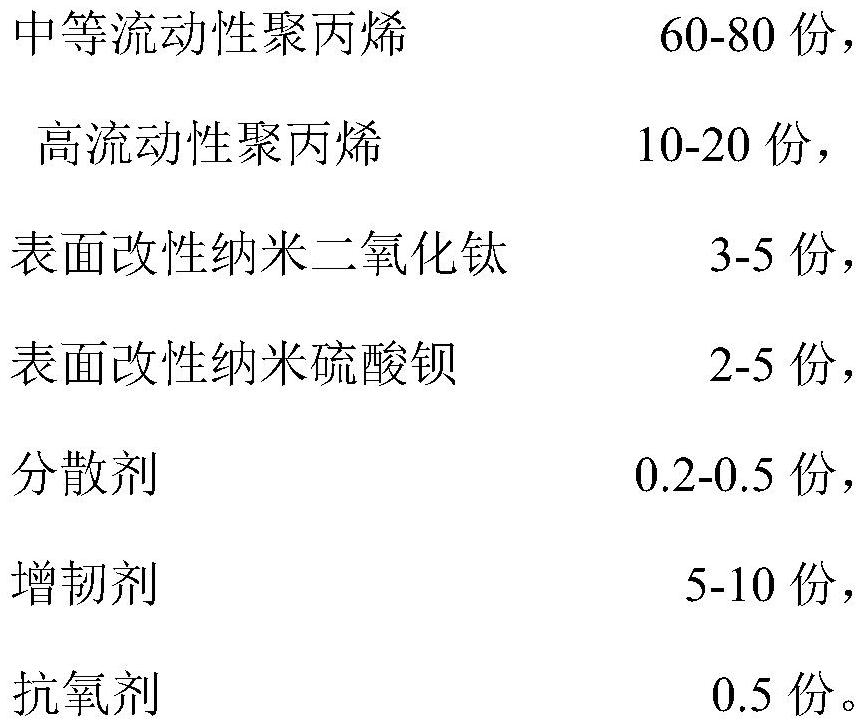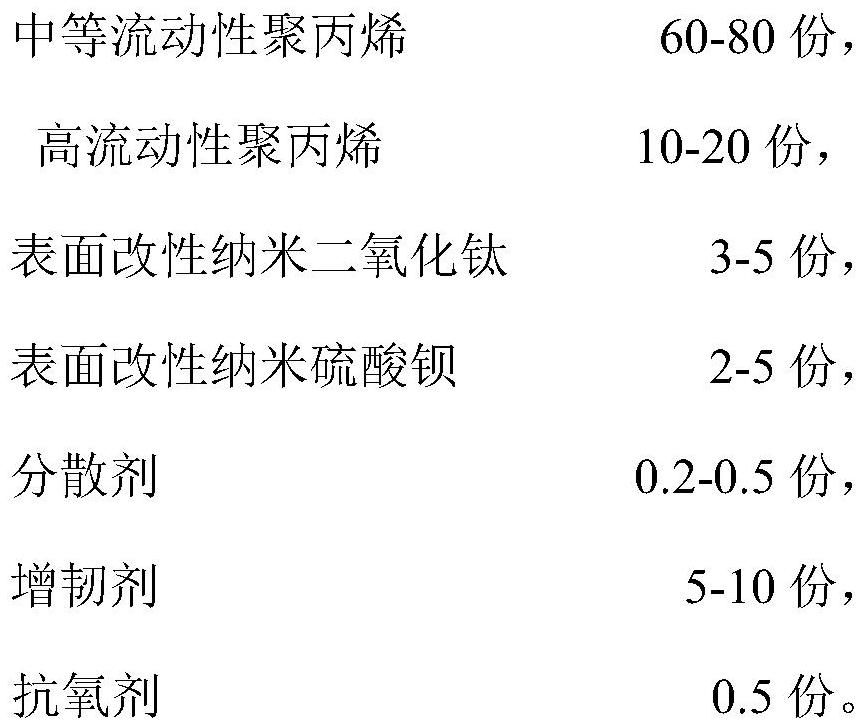High-shading polypropylene composition and preparation method thereof
A polypropylene composition, high shading technology, applied in the field of modified materials, can solve the problems of material mechanical properties decline, high addition amount, limit material application, etc., achieve compatibility improvement, less addition amount, good shading effect Effect
- Summary
- Abstract
- Description
- Claims
- Application Information
AI Technical Summary
Problems solved by technology
Method used
Image
Examples
Embodiment 1
[0030] 60 parts of medium-fluidity polypropylene, 20 parts of high-fluidity polypropylene, 5 parts of surface-modified nano-titanium dioxide, 5 parts of surface-modified nano-barium sulfate, 0.5 parts of dispersant, 10 parts of toughening agent, and 0.5 parts of antioxidant Add it to a high-speed mixer and mix it at high speed for 5 minutes, then put the uniformly mixed material into a twin-screw extruder, knead, extrude, cool and cut into pellets to obtain the final product. The extrusion temperatures of each extrusion zone in the twin-screw extruder are 165°C, 175°C, 185°C, 195°C, 195°C, 195°C, 200°C, 200°C, 200°C, 200°C respectively. The product performance is shown in Table 1
Embodiment 2
[0032] 70 parts of medium-fluidity polypropylene, 15 parts of high-fluidity polypropylene, 4 parts of surface-modified nano-titanium dioxide, 4 parts of surface-modified nano-barium sulfate, 0.4 parts of dispersant, 7 parts of toughening agent, and 0.5 parts of antioxidant Add it to a high-speed mixer and mix it at high speed for 5 minutes, then put the uniformly mixed material into a twin-screw extruder, knead, extrude, cool and cut into pellets to obtain the final product. The extrusion temperatures of each extrusion section in the twin-screw extruder are 160°C, 170°C, 180°C, 190°C, 190°C, 190°C, 190°C, 195°C, 195°C, 195°C respectively. The product performance is shown in Table 1
Embodiment 3
[0034] 80 parts of medium-fluidity polypropylene, 10 parts of high-fluidity polypropylene, 3 parts of surface-modified nano-titanium dioxide, 2 parts of surface-modified nano-barium sulfate, 0.2 parts of dispersant, 5 parts of toughening agent, and 0.5 parts of antioxidant Add it to a high-speed mixer and mix it at high speed for 5 minutes, then put the uniformly mixed material into a twin-screw extruder, knead, extrude, cool and cut into pellets to obtain the final product. The extrusion temperatures of each extrusion zone in the twin-screw extruder are 155°C, 165°C, 175°C, 185°C, 185°C, 185°C, 185°C, 185°C, 185°C, 190°C respectively. The product performance is shown in Table 1
[0035] The performance detection of the product that each embodiment of table 1 makes
[0036]
[0037]
[0038] Note: The conditions of the above tests and the dimensions of the test strips in Table 1 are as follows:
[0039] Flexural modulus test: sample size 100mm*10mm*4mm, bending speed 2...
PUM
| Property | Measurement | Unit |
|---|---|---|
| melt flow index | aaaaa | aaaaa |
Abstract
Description
Claims
Application Information
 Login to View More
Login to View More - R&D
- Intellectual Property
- Life Sciences
- Materials
- Tech Scout
- Unparalleled Data Quality
- Higher Quality Content
- 60% Fewer Hallucinations
Browse by: Latest US Patents, China's latest patents, Technical Efficacy Thesaurus, Application Domain, Technology Topic, Popular Technical Reports.
© 2025 PatSnap. All rights reserved.Legal|Privacy policy|Modern Slavery Act Transparency Statement|Sitemap|About US| Contact US: help@patsnap.com



